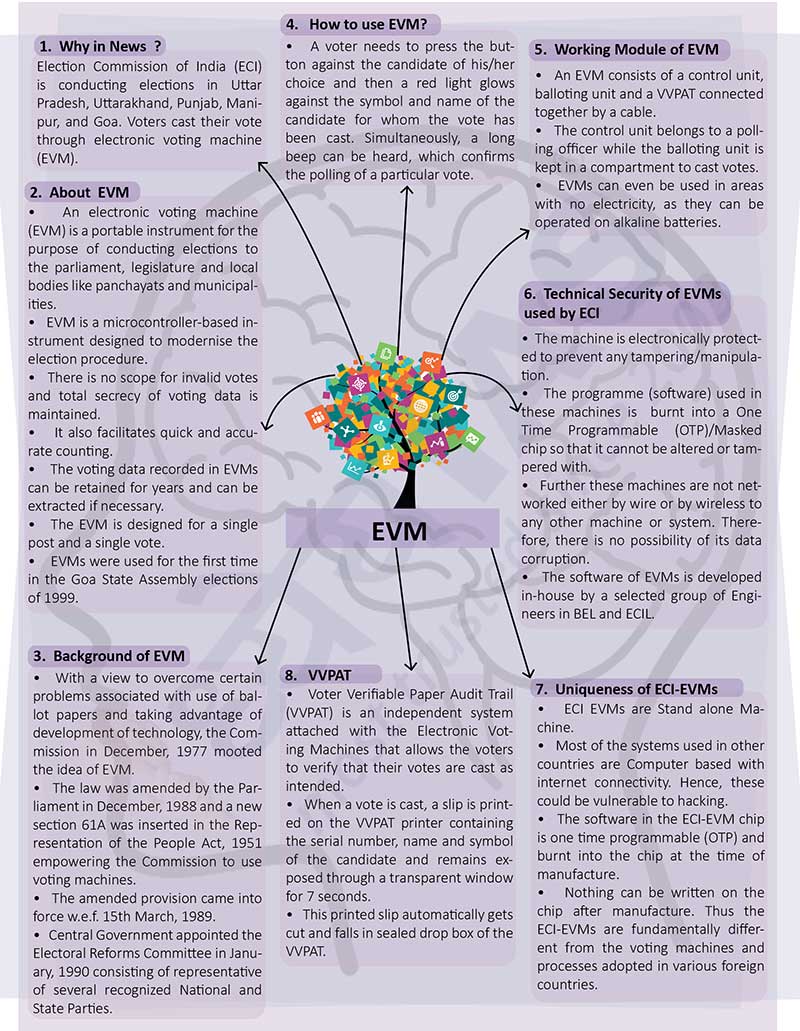Brain-booster
/
25 Mar 2022
Brain Booster for UPSC & State PCS Examination (Topic: EVM - Electronic Voting Machine)

Why in News?
- Election Commission of India (ECI) is conducting elections in
UttarPradesh, Uttarakhand, Punjab, Manipur, and Goa. Voters cast their vote
through electronic voting machine (EVM).
About EVM
- An electronic voting machine (EVM) is a portable instrument for the
purpose of conducting elections to the parliament, legislature and local
bodies like panchayats and municipalities.
- EVM is a microcontroller-based instrument designed to modernise the
election procedure.
- There is no scope for invalid votes and total secrecy of voting data is
maintained.
- It also facilitates quick and accurate counting.
- The voting data recorded in EVMs can be retained for years and can be
extracted if necessary.
- The EVM is designed for a single post and a single vote.
- EVMs were used for the first time in the Goa State Assembly elections of
1999.
Background of EVM
- With a view to overcome certain problems associated with use of ballot
papers and taking advantage of development of technology, the Commission in
December, 1977 mooted the idea of EVM.
- The law was amended by the Parliament in December, 1988 and a new
section 61A was inserted in the Representation of the People Act, 1951
empowering the Commission to use voting machines.
- The amended provision came into force w.e.f. 15th March, 1989.
- Central Government appointed the Electoral Reforms Committee in January,
1990 consisting of representative of several recognized National and State
Parties.
How to use EVM?
- A voter needs to press the button against the candidate of his/her
choice and then a red light glows against the symbol and name of the
candidate for whom the vote has been cast. Simultaneously, a long beep can
be heard, which confirms the polling of a particular vote.
Working Module of EVM
- An EVM consists of a control unit, balloting unit and a VVPAT connected
together by a cable.
- The control unit belongs to a polling officer while the balloting unit
is kept in a compartment to cast votes.
- EVMs can even be used in areas with no electricity, as they can be
operated on alkaline batteries.
Technical Security of EVMs used by ECI
- The machine is electronically protected to prevent any
tampering/manipulation.
- The programme (software) used in these machines is burnt into a One Time
Programmable (OTP)/Masked chip so that it cannot be altered or tampered
with.
- Further these machines are not networked either by wire or by wireless
to any other machine or system. Therefore, there is no possibility of its
data corruption.
- The software of EVMs is developed in-house by a selected group of
Engineers in BEL and ECIL.
Uniqueness of ECI-EVMs
- ECI EVMs are Stand alone Machine.
- Most of the systems used in other countries are Computer based with
internet connectivity. Hence, these could be vulnerable to hacking.
- The software in the ECI-EVM chip is one time programmable (OTP) and
burnt into the chip at the time of manufacture.
- Nothing can be written on the chip after manufacture. Thus the ECI-EVMs
are fundamentally different from the voting machines and processes adopted
in various foreign countries.
VVPAT
- Voter Verifiable Paper Audit Trail (VVPAT) is an independent system
attached with the Electronic Voting Machines that allows the voters to
verify that their votes are cast as intended.
- When a vote is cast, a slip is printed on the VVPAT printer containing
the serial number, name and symbol of the candidate and remains exposed
through a transparent window for 7 seconds.
- This printed slip automatically gets cut and falls in sealed drop box of
the VVPAT.







